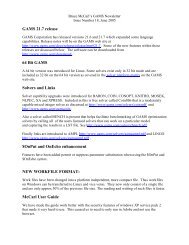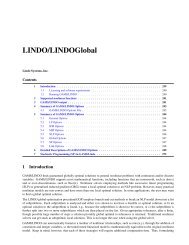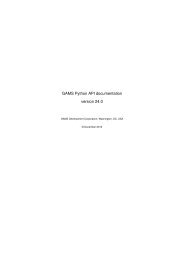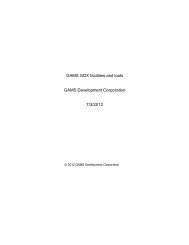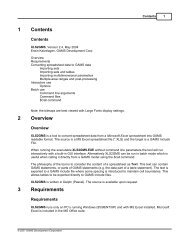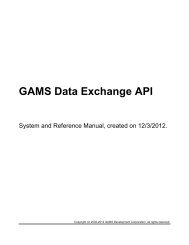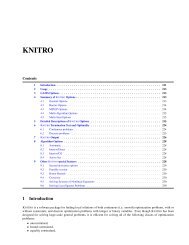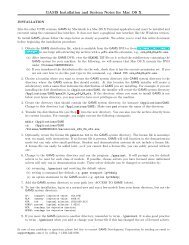Economic Equilibrium Modeling with GAMS
Economic Equilibrium Modeling with GAMS
Economic Equilibrium Modeling with GAMS
You also want an ePaper? Increase the reach of your titles
YUMPU automatically turns print PDFs into web optimized ePapers that Google loves.
16<br />
Good<br />
Y<br />
Agent<br />
A<br />
Figure 7. The Edgeworth-Bowley Box<br />
` is the value share of leisure (Shl),<br />
LEIS is the benchmark demand for leisure,<br />
LSUP is the benchmark supply of labor, and<br />
is the compensated labor supply elasticity.<br />
Ay’<br />
Bx’<br />
*<br />
Ax’<br />
E<br />
Endowment<br />
Good<br />
X<br />
5. The Pure Exchange Model<br />
Partial equilibrium analysis forms the basis of most economics courses at the undergraduate<br />
level. In these models we focus on price, supply and demand for a single commodity.<br />
The partial equilibrium approach neglects indirect e ects, through which changes in the<br />
demand or supply for one good may in uence the market for another good.<br />
In the previous section, we focused on the choices of a single consumer. In the present<br />
section, we will explore the implications of interactions between many consumers <strong>with</strong><br />
heterogeneous preferences. Furthermore, the analysis will explore the potentially important<br />
interaction between market prices and income which are determined jointly in a general<br />
equilibrium.<br />
The most widely-used graphical framework for multi-agent exchange equilibrium analysis<br />
is the Edgeworth-Bowley box as illustrated in Figure 7. In this diagram we model the<br />
following economy:<br />
Two types of consumers, denoted A and B. We consider A and H to each represent<br />
many households, each <strong>with</strong> the same endowments and preferences. (This assumption<br />
justi es an assumption of perfectly competitive, price-taking behavior.) There are two<br />
commodities in the model, denoted x and y Each consumer has xed endowments of both<br />
goods. The horizontal axis measures the total world endowment of good x. The vertical<br />
axis measure the total world endowment ofgoody. Anypointinthebox then represents<br />
an allocation of goods between the two agents. The agent H allocation is measured <strong>with</strong><br />
respect to the lower left origin. The agent F allocation is measured <strong>with</strong> respect to the<br />
upper right origin.<br />
Each agent has a given initial endowment, here denoted point E. Furthermore, we<br />
assume that there is no possibility for trade. The indi erence curves through point E<br />
therefore represent autarchy welfare levels.<br />
Agent<br />
B<br />
By’



